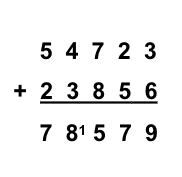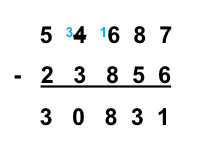In this activity, we are going to practise adding and subtracting numbers with four or more digits.
The column method is an efficient method for adding and subtracting large numbers, so this is what we are going to use.
We will be exchanging/carrying in some questions - sometimes more than once!

Top Tips:
Write each question out clearly - it can be useful to use squared paper if you are writing out the questions.
Check the digits are in the correct order (it is easy to muddle them up!)
Make sure each digit is in the correct column.
Start at the ones and work towards the left-hand column.
We could use the inverse operation to check our answers!
When subtracting, we can't reverse the order of the digits (3 - 8 can't become 8 - 3)
Example
Add together 54,723 + 23,856

We set out the question as shown in the example above.
Each digit must go in the correct column as shown.
We then add the columns together starting with the ones column.
The ones: 3 + 6 = 9 We put the 9 in the ones column.
The tens: 2 + 5 = 7 (20 + 50 = 70)
The hundreds: 7 + 8 = 15 (700 + 800 = 1,500)
We put the 5 (500) in the hundreds column and carry 1 (1,000) over to the thousands column.
The thousands: 4 + 3 + 1 (carried over) = 8 (4,000 + 3,000 + 1,000 = 8,000)
The ten thousands: 5 + 2 = 7 ( 50,000 + 20,000 = 70,000)
The answer is 78,579
Have another read through the example if you need to!

Now let's have a look at a subtraction question:
54,687 - 23,856 =

We write the number we are subtracting below the starting number.
We start with the ones column.
The ones: 7 - 6 = 1
The tens: 8 - 5 = 3 (80 - 50 = 30)
The hundreds: 6 - 8 (600 - 800) We can't subtract 8 from 6 (we mustn't swap around and subtract 6 from 8)
We need to exchange 1,000 and put it into the hundreds column.
Now we have 16 - 8 = 8 (1,600 - 800 = 800) which we can do.
The thousands: As we have taken a thousand, we need to adjust this column. The 4 (4,000) becomes 3 (3,000)
3 - 3 = 0 (3,000 - 3,000 = 0) We must put the 0 as a placeholder.
The ten thousands: 5 - 2 = 3 (50,000 - 20,000 = 30,000)
The answer is 30,831
Now why don't we have a go at answering some questions?
Remember, we can do the inverse (opposite) operation to check answers!
Come back and look at the examples if you get stuck by clicking on the red help button.







